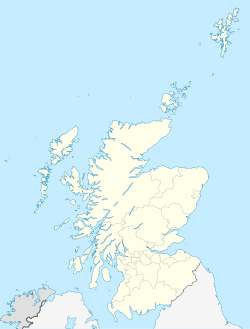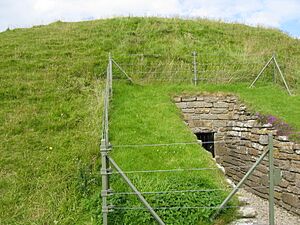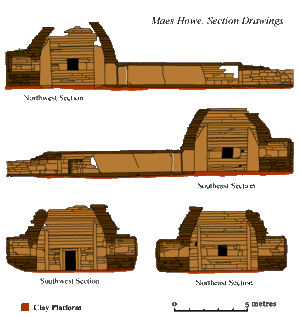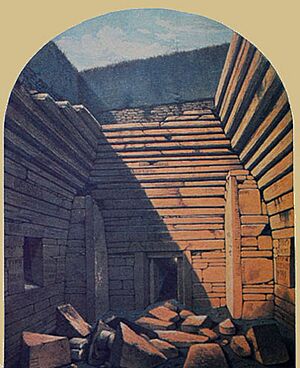Maeshowe facts for kids
|
Orkahaugr (Old Norse)
|
|
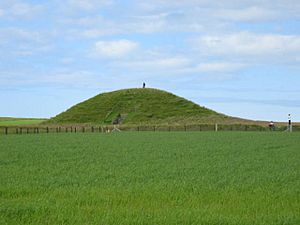
The chambered cairn in 2006
|
|
| Alternative name | Maes Howe |
|---|---|
| Location | Stenness, Scotland, United Kingdom |
| Coordinates | 58°59′48″N 3°11′18″W / 58.9966°N 3.1882°W |
| Type | Chambered cairn |
| Diameter | 35 meters |
| Height | 7.3 meters |
| History | |
| Material | Stone |
| Founded | c. 2800 BC |
| Periods | Neolithic |
| Site notes | |
| Ownership | Historic Scotland |
| Public access | Yes |
| Type | Cultural |
| Criteria | i, ii, iii, iv |
| Designated | 1999 (23rd session) |
| Part of | Heart of Neolithic Orkney |
| Reference no. | 514 |
| Region | Europe and North America |
| Identifiers | |
| Historic Environment Scotland | SM90209 |
Maeshowe (also called Maes Howe) is a very old stone building from the Neolithic period, which means the New Stone Age. It's a type of tomb called a chambered cairn or passage grave. You can find it on Mainland Orkney, Scotland.
Experts believe Maeshowe was built around 2800 BC, which is about 4,800 years ago! It's so special that a whole group of similar tombs in Orkney are named after it. Maeshowe is known for its amazing design and how well it was built. An archaeologist named Stuart Piggott even called it a "superlative monument."
Today, Maeshowe is a protected historical site. It's also part of the "Heart of Neolithic Orkney" group, which includes other famous places like Skara Brae. This whole area was made a UNESCO World Heritage Site in 1999 because of its global importance.
Contents
Exploring Maeshowe's Design
Maeshowe is one of the biggest ancient tombs in Orkney. The grassy mound covering the tomb is about 35 meters (115 feet) wide. It rises to a height of about 7.3 meters (24 feet). Around the mound, there's a ditch that's up to 14 meters (45 feet) wide.
How Maeshowe Was Built
The grassy mound hides a clever system of passages and rooms. These are made from carefully shaped stone slabs, some weighing as much as 30 tons! The builders were very skilled. The tomb is built so that the back wall of its main room is lit up by the sun during the winter solstice. This is the shortest day of the year. A similar thing happens at another famous ancient site called Newgrange in Ireland.
The entrance passage is about 11 meters (36 feet) long. It leads to the main room, which is almost square, about 4.5 meters (15 feet) on each side. The room is currently about 3.8 meters (12.5 feet) high. This is how high the original stone walls are, topped with a modern roof. The original roof might have been even taller, perhaps 4.5 meters (15 feet) or more.
The entrance passage is quite low, only about 0.9 meters (3 feet) high. This means visitors have to bend down or crawl to get into the main room. The main room is built mostly from flat stone slabs. Many of these slabs run almost the entire length of the walls. In each corner, there are huge angled supports that go up towards the roof. About 0.9 meters (3 feet) up, the walls change. They start using overlapping slabs to create a beehive-shaped roof.
Building Maeshowe: A Huge Effort
Building Maeshowe took a lot of work! Some experts think it took about 39,000 hours of human labor. Others believe it could have been more than 100,000 hours. It's hard to know exactly when Maeshowe was built. But similar tombs suggest a date around 3000 BC. Since Maeshowe is the biggest and most complex of its kind, archaeologists think it was built a bit later, around 2800 BC. The people who built Maeshowe used a special type of pottery called "grooved ware." This pottery style was common across Britain around 3000 BC.
Maeshowe's Location and Connections
Maeshowe looks like a grassy hill rising from a flat area near the Loch of Harray. The land around Maeshowe probably looked similar when it was built. It was treeless, with grasses and signs of farming, especially raising animals.
Ancient Alignments
Maeshowe is connected to other ancient sites nearby. For example, the entrance of "Structure 8" at the Barnhouse Settlement faces Maeshowe directly. Also, a stone called the "Barnhouse Stone," about 700 meters away, lines up perfectly with Maeshowe's entrance. This entrance passage is placed so that the setting sun shines directly into the chamber for a few days around the winter solstice. It even lights up the entrance to a small back room.
Neolithic Roads and Sites
A very old "low road" connects Maeshowe to the well-preserved village of Skara Brae. This road passes near the Standing Stones of Stenness and the Ring of Brodgar. These "low roads" linked important ancient sites all over Britain. Some archaeologists think Maeshowe was once surrounded by a large stone circle.
The area around Maeshowe, including the Ring of Brodgar, the Standing Stones of Stenness, and Skara Brae, has many important Neolithic sites. Only the areas around Stonehenge and Avebury in Britain have as many ancient wonders.
Visiting Maeshowe Today
The Maeshowe Heart of Neolithic Orkney Visitor Centre opened in April 2017 in Stenness Village. Before that, the visitor center was at Tormiston Mill, right next to the tomb. That old center closed in September 2016 because its parking lot was too small, the road was dangerous, and it wasn't wheelchair friendly.
Tours to Maeshowe now start from the new visitor center. A shuttle bus takes groups of 16 people to the tomb several times a day. The center has an exhibition, a gift shop, and public restrooms.
Maeshowe's Unique Style
Maeshowe is so special that it gives its name to a type of ancient Scottish tomb, found only in Orkney. Maeshowe is very similar to the famous Newgrange tomb in Ireland. This suggests that the people who built them might have had connections.
What Makes a Maeshowe-Type Tomb?
Maeshowe-type tombs have a long, low entrance passage. This leads to a square or rectangular main room. From this main room, you can usually find several smaller side rooms. While there are some disagreements, only seven tombs are definitely known to be Maeshowe-type. Besides Maeshowe itself, these include Cuween Hill, Wideford Hill, and Quanterness on Mainland Orkney. There's also Quoyness on Sanday, Vinquoy Hill on Eday, and an unnamed tomb on the Holm of Papa Westray.
Interestingly, while many ancient tombs contain human remains or grave goods, Maeshowe did not. This has led some experts to wonder if it was used for more than just burials.
Was Maeshowe an Observatory?
Some researchers, like Peter Tompkins, have suggested that Maeshowe might have been used as an observatory or a calendar, not just a tomb. In 1971, Tompkins compared Maeshowe to the Great Pyramid of Giza in Egypt. He thought the main room at Maeshowe, with its special roof, was like the Great Pyramid's Grand Gallery. He believed it was carefully built for observing the sky.
Tompkins suggested that the entrance passage, which is 16.5 meters (54 feet) long, was like a telescope. It was aimed at a large stone about 845 meters (2772 feet) away to mark the summer solstice. He also mentioned a "Watchstone" to the west that might have marked the equinoxes. He pointed out that the "sighting passage" points to a northern star, similar to some Egyptian pyramids. Tompkins found the similarities "amazing." He even mentioned Professor Alexander Thom, an expert from Oxford, who wrote about Maeshowe's geometry and how it lined up with the stars.
Tompkins, along with others, believed that Maeshowe and other ancient mounds in Britain were very accurate observatories and calendars. They might have also been used as beacons for travelers and for special ceremonies, like May Day celebrations, over 4,000 years ago.
Maeshowe's History: Excavation and Vikings
The "modern" discovery of Maeshowe happened in July 1861. It was opened by James Farrer, a politician and collector of old things. Unfortunately, Farrer wasn't very careful when he dug up sites. He and his workers broke through the roof of the entrance passage. They found it filled with dirt. Then they dug through the top of the mound and emptied the main room.
Inside, they found famous runic inscriptions carved on the walls. These carvings were proof that Norsemen, or Vikings, had broken into the tomb at least six centuries earlier.
Viking Visitors
According to the Orkneyinga saga, a collection of old Norse stories, Maeshowe was robbed by famous Vikings like Earl Harald Maddadarson and Ragnvald around the 12th century. The more than 30 runic inscriptions on the walls are the largest collection of such carvings in the world. Recent studies using special photography have helped us understand these carvings better.
Digs have also shown that the outer wall around the ditch was rebuilt in the 9th century. Some archaeologists think this means the Norse people might have used the tomb again. They might even have been the source of the "treasure" that later robbers found.
Maeshowe's World Heritage Status
The "Heart of Neolithic Orkney" was named a World Heritage site in December 1999. This important site includes Maeshowe, Skara Brae, the Standing Stones of Stenness, the Ring of Brodgar, and other nearby places.
Historic Environment Scotland manages the site. They describe Maeshowe as a "masterpiece of Neolithic engineering." They say it's an "exceptionally early architectural accomplishment" that has survived for 5,000 years. They believe it shows the amazing skill of people whose other tombs were much smaller.
See also
 In Spanish: Maeshowe para niños
In Spanish: Maeshowe para niños
- Newgrange — another ancient tomb lit by the winter solstice sun
- Ring of Brodgar
- Skara Brae
- Standing Stones of Stenness
- Heart of Neolithic Orkney
- Prehistoric Orkney


